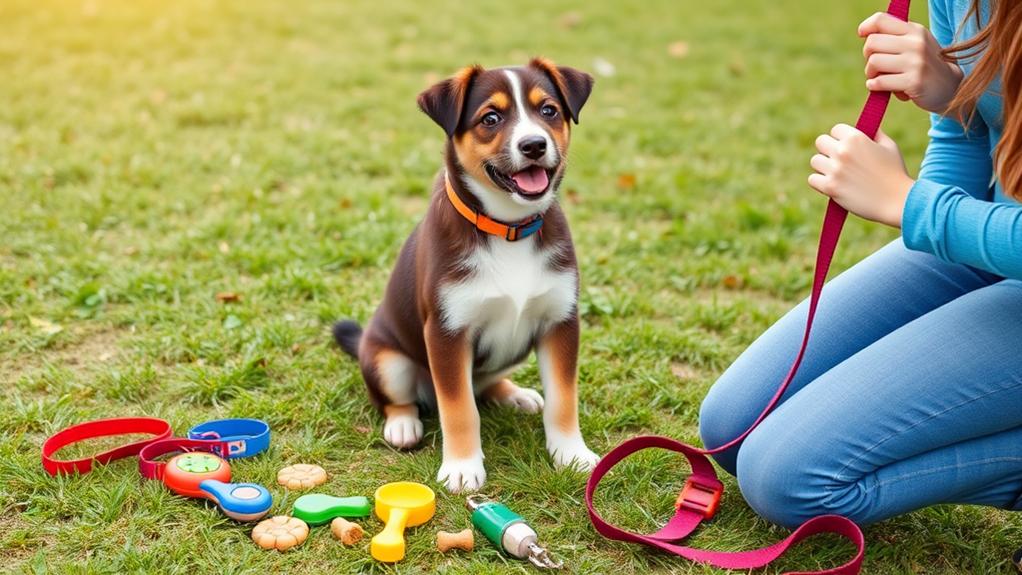Did you know that approximately 30% of dog owners report struggling with training their puppies? You might find yourself among this group, questioning the most effective methods to shape your pup's behavior. Understanding the essential steps can make a significant difference in your training journey. From establishing a routine to using positive reinforcement, the techniques you choose will impact your puppy's development. So, what are the critical components that can help you achieve a well-behaved companion?
Understanding Puppy Behavior
Understanding your puppy's behavior is essential for effective training. Puppies communicate through their actions, sounds, and body language, so paying attention to these cues can help you respond appropriately. For instance, if your puppy barks or whines, it might indicate excitement, anxiety, or a need for attention. Recognizing the context behind these behaviors allows you to address their needs more effectively.
One common behavior you may notice is chewing. Puppies explore their world using their mouths, but they also chew to relieve teething discomfort. Providing appropriate chew toys can redirect this natural urge and save your furniture.
Similarly, jumping up on you or others is often a sign of excitement. Instead of scolding, teach your puppy to greet people calmly by rewarding them when all four paws are on the ground.
Socialization is another critical aspect of understanding behavior. Exposing your puppy to various environments, people, and other animals helps them develop confidence and reduces the likelihood of fear-based behaviors.
Essential Training Supplies
To train your puppy effectively, having the right supplies on hand makes a significant difference. Start with a sturdy leash and a comfortable collar or harness. These will help you maintain control during walks and training sessions.
Don't forget to choose a good quality training clicker or whistle; these tools can help you communicate commands clearly and reinforce positive behavior.
Next, invest in high-value treats that your puppy loves. Small, soft treats work best because they're easy to chew and can be quickly rewarded.
You'll also want to have a variety of toys, including chew toys and interactive puzzle toys, to keep your puppy engaged and stimulated.
A designated training area is essential, too. Whether it's a quiet corner in your home or a secure outdoor space, having a consistent location can help your puppy focus.
Finally, consider getting a crate for house training. It provides a safe space for your puppy and aids in establishing boundaries.
Having these essential training supplies ready guarantees you're well-prepared for your puppy training journey, making the process smoother and more enjoyable for both of you.
Establishing a Routine
Creating a consistent training schedule is essential for your puppy's development and helps establish good habits. By setting a routine, you make it easier for your puppy to understand what's expected of them.
Start by choosing specific times for training sessions, feeding, bathroom breaks, and playtime. This predictability helps your puppy feel secure and can reduce anxiety.
Aim for short training sessions, around 5 to 10 minutes, focusing on one command or skill at a time. Puppies have short attention spans, so breaking training into manageable chunks keeps them engaged.
Stick to your chosen times, even on weekends. Consistency is key.
Incorporate your puppy's training into daily activities. For example, practice commands during walks or while playing fetch. This not only reinforces learning but also strengthens your bond.
Don't forget to adjust your routine as your puppy grows. As they gain confidence and understanding, you can gradually increase the complexity of commands or extend training sessions.
Positive Reinforcement Techniques
Using positive reinforcement techniques is one of the most effective ways to train your puppy and build a trusting relationship. This method involves rewarding your puppy immediately after they perform the desired behavior, which helps them understand what you expect. Rewards can include treats, praise, or playtime—whatever motivates your puppy most.
When you start training, keep it simple. Focus on basic commands like "sit," "stay," or "come." Each time your puppy successfully follows your command, reward them promptly. This timing is vital; it helps your puppy connect the action with the reward.
Consistency is key. Use the same commands and rewards every time, so your puppy learns to recognize them. If they don't respond, don't punish them; instead, try to understand why they didn't comply. Maybe they're distracted, or the reward isn't appealing enough.
Practice short training sessions of about 5-10 minutes each, multiple times a day. Puppies have short attention spans, so keeping it brief and fun keeps them engaged.
Over time, gradually reduce the frequency of treats, but continue to praise your puppy for their good behavior. This approach will foster a strong bond and promote effective learning.
Socialization Strategies
Socializing your puppy is essential for their development, and starting this process early can make a significant difference.
Begin by exposing your puppy to various environments, sounds, and experiences. Take them on walks through busy parks, busy streets, or even pet-friendly stores. This helps them adapt to different sights and sounds, building their confidence.
Introduce your puppy to other dogs and friendly people. Arrange playdates with vaccinated dogs to help them learn appropriate social cues. Make certain these interactions are positive; use treats and praise to reward calm behavior.
Enroll in a puppy socialization class, where they can meet other puppies in a controlled setting. This structured environment guarantees safety while promoting interaction.
Don't forget to expose your puppy to different surfaces—grass, concrete, and gravel—to familiarize them with varied textures.
Lastly, keep an eye on your puppy's body language. If they seem overwhelmed, give them a break and try again later.
Common Training Challenges
Training a puppy can present various challenges that every owner should be prepared for. One of the most common issues is house training. Accidents will happen, and it's vital to remain patient and consistent. Establish a routine for bathroom breaks, and reward your puppy for doing their business outside.
Another challenge is dealing with distractions. Puppies are naturally curious, and they can easily lose focus during training sessions. To combat this, choose a quiet environment for training and gradually introduce distractions as your puppy improves.
Barking and chewing can also be problematic. If your puppy barks excessively or chews on furniture, identify the triggers and redirect their behavior. Provide appropriate chew toys and engage in play to keep them occupied.
Progress Tracking Methods
To keep track of your puppy's progress, it's important to set clear goals and monitor their development regularly. Start by defining specific objectives for each training session, such as mastering sit, stay, or leash walking. Write these goals down, and refer back to them as you train.
Next, maintain a training log. This can be a simple notebook or a digital document where you record each session's date, duration, and activities. Note your puppy's behavior, any challenges faced, and successes achieved. This log will serve as a valuable reference to see how your puppy evolves over time.
In addition, consider using a progress chart. Visual aids, like graphs or checklists, can help illustrate your puppy's achievements and areas needing improvement. This can motivate both you and your puppy, as you'll see tangible results from your efforts.
Lastly, don't forget to celebrate milestones, no matter how small. Positive reinforcement, like treats or praise, will encourage your puppy to keep learning and growing.
Conclusion
In puppy training, consistency and positivity are your best friends, much like a sturdy leash guiding your pup on a walk. By understanding your puppy's behavior, using the right supplies, and socializing them effectively, you'll build a strong foundation for a well-behaved dog. Remember to embrace challenges as part of the journey, tracking your progress along the way. With patience and love, you'll watch your puppy thrive, turning training into a rewarding adventure for both of you.



